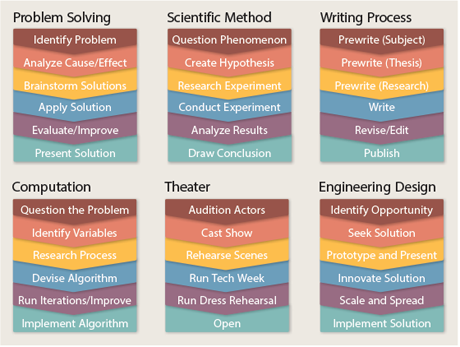Web Page: Merriam Webster, "Prototype"
Web Page: BusinessDictionary.com, "Stakeholder"
PDF Document: SDSC, "Computational Thinking"
Web Site: CS4FN, "What Is Computational Thinking?"
Creating brings together all the other levels of thinking. As the definitive step in the inquiry process, creating allows you to express what you have learned.
Different disciplines follow different versions of the inquiry process. Here are six specific versions, meant to accomplish different tasks.

Consider how the inquiry process can be used to create the essentials listed here:
Your Turn Think of something that you know how to create—a painting, an equation, a club, a homemade pizza. What process do you use? How is your process similar to or different from the processes charted above?
The engineering-design process has produced the computer revolution and the information age. Mastering this process can give you a key to the future. Here is one version of this powerful process.
Critical Thinking | Inquiry Process |
See the Problem Engineers see problems as opportunities. When something is inefficient, inconvenient, or unrealized, engineers see ways to innovate solutions. | Identify |
Brainstorm a Solution Engineers brainstorm solutions, sometimes focusing on specific problems and sometimes seeking approaches that completely overthrow conventional wisdom. | Seek |
Prototype After choosing a solution, engineers prototype it. They try it on a small scale, in drawings and wire frames. Then they present their idea to key stakeholders (decision makers who are invested in solving the problem). | Prototype and |
Build Once a prototype is okayed, engineers build the full-scale version of their solution. They test their design, making improvements along the way. | Innovate |
Review The full-size solution goes through another review period with stakeholders, and engineers make more changes. Then they work out ways to replicate the solution and market it to those who need it. | Scale and |
Implement Once the solution is ready, engineers implement it, whether in one place or many. A time line of the last decade would show how many new, life-changing technologies have been implemented. | Implement |
Your Turn Practice engineering-design thinking. Start by identifying some design opportunities in your school, community, or home. Note inefficiencies, inconveniences, and unrealized possibilities. Select a problem that you would like to tackle, and then follow the steps above to design a solution.
Obviously, computational thinking has given us our modern computer age. When you identify a series of discrete commands to accomplish a task, you are thinking computationally. This kind of thinking takes many forms:

Your Turn Which type of computational thinking are you most familiar with? Which type are you least familiar with? How can learning to write a clear set of instructions help you learn to write computer code? How can understanding mathematical computation help you write computer code?
Web Page: Merriam Webster, "Prototype"
Web Page: BusinessDictionary.com, "Stakeholder"
PDF Document: SDSC, "Computational Thinking"
Web Site: CS4FN, "What Is Computational Thinking?"
© 2014 Thoughtful Learning
